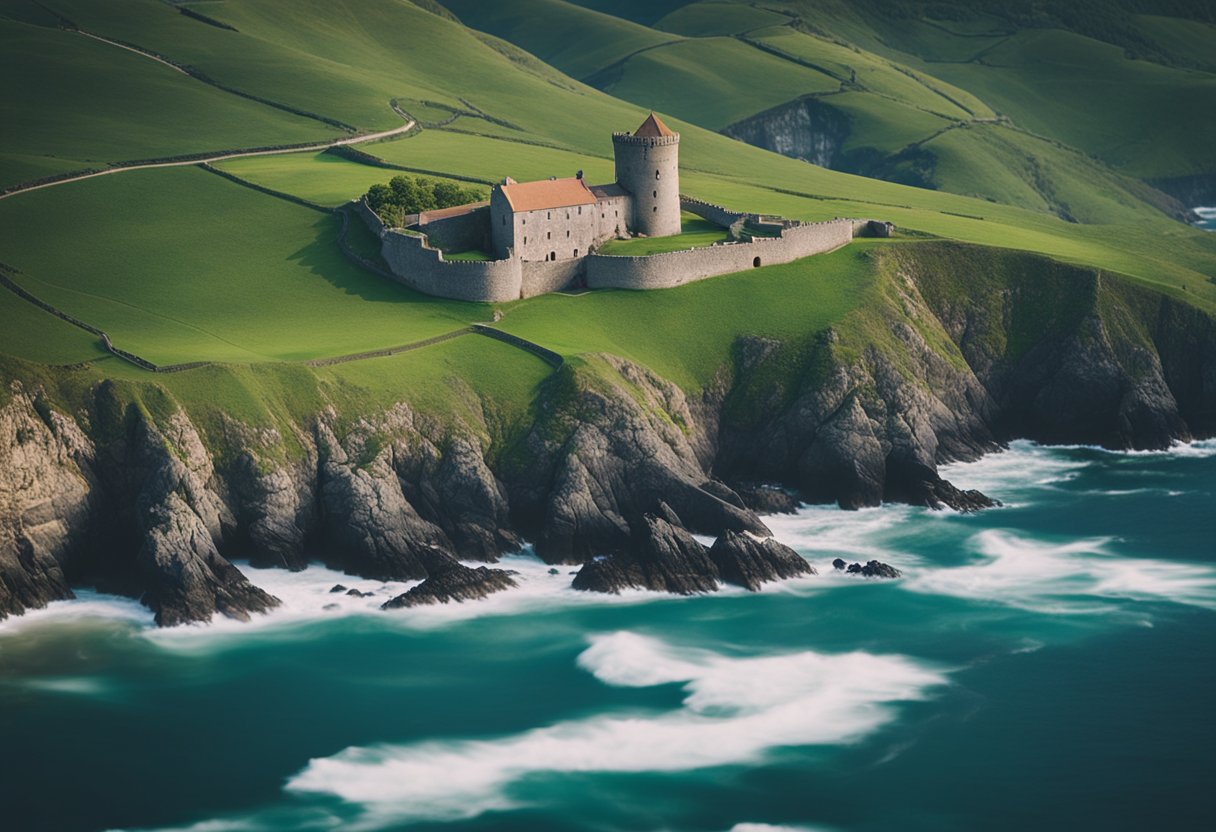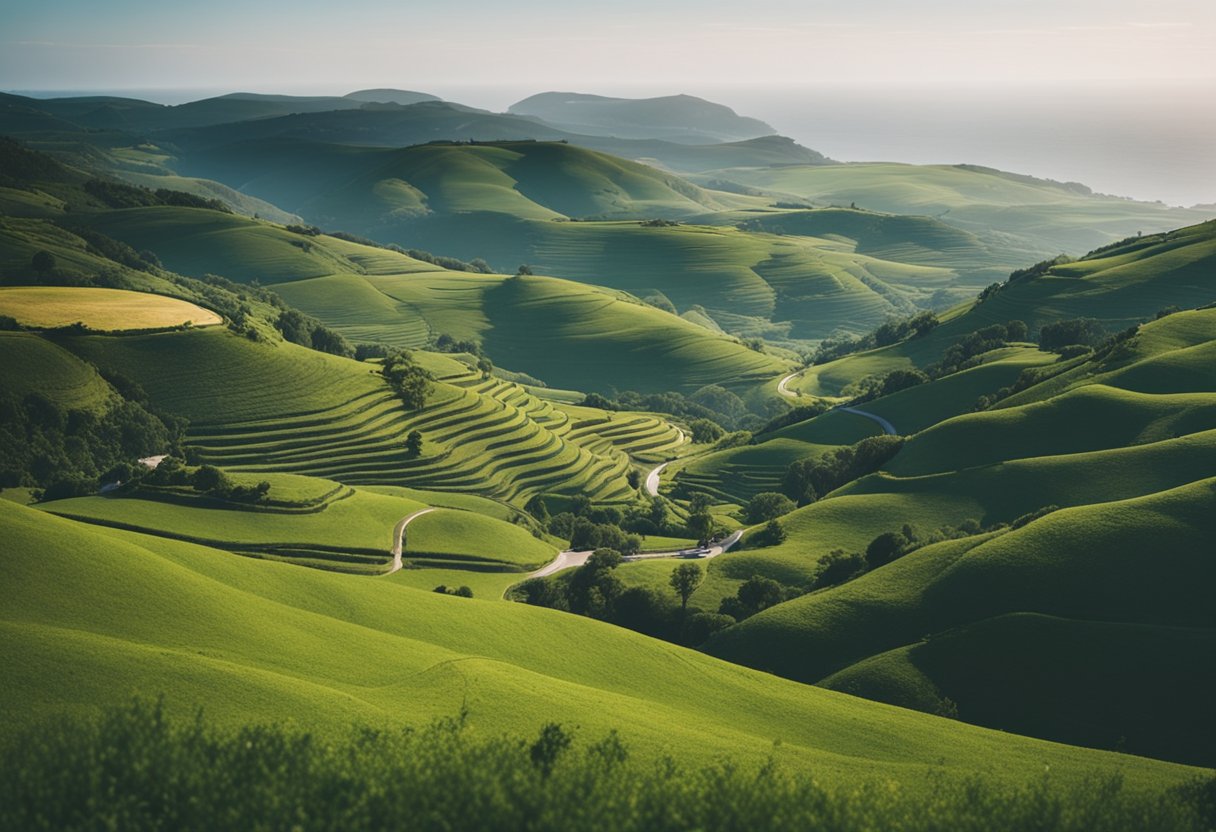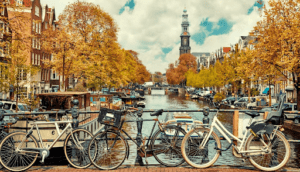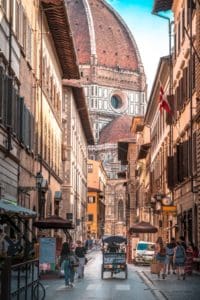A Cinematic Journey Through Ireland’s Iconic Film Locations

Updated On: April 23, 2024 by Raghda Elsabbagh
Ireland, with its rugged coastlines, sweeping landscapes, and historic architecture, has become a cherished backdrop for some of the most beloved movies and TV shows. Our cinematic journey through Ireland will transport us to the very spots where directors have captured the essence of storytelling, transforming Ireland’s natural beauty into visual poetry on screen. From the cobbled streets that echo the bustling life of Dublin’s cityscape to the silence that clings to the dramatic cliffs in the west, each location whispers tales of a bygone era, etched into reel life.

As we traverse through Ireland’s varied terrain, we uncover the layers of our on-screen heritage, visiting locations that have not only framed classic cinema but also offered a canvas to contemporary tales. The magnetic charm of Irish settings has lured audiences into fantastical worlds and grounded dramas alike. It’s here where fantasy and reality collide, creating a haven for filmmakers and a voyage for film enthusiasts. Whether it’s retracing the steps of Jedi knights along the Skellig Michael or strolling through the Wicklow mountains, reminiscing about epic love stories, Ireland’s landscapes have been immortalised through the camera lens.
Table of Contents
The Role of Ireland in Cinema
Ireland’s lush landscapes and rich history have long been utilised by filmmakers across the globe. The Emerald Isle has provided a versatile backdrop for cinematic storytelling, from Hollywood blockbusters to European art-house films.
Historic Contributions
The Irish film industry, ignited notably by figures like James Joyce, has become well-regarded for fostering talent. Throughout the years, indigenous production has grown, with Ireland now being celebrated for producing a variety of both fiction films and documentaries. Our presence in cinema has evolved beyond the scenic backdrop, with Irish filmmakers earning international acclaim.
Emerald Landscapes
Ireland’s appeal to Hollywood is undeniable, with our breathtaking scenery featured in numerous productions. The diversity of our landscape lends itself to various genres, from fantastical epics to intimate dramas. Its portrayal in cinema has often captured the essence of the Irish spirit.
Sustainable Filmmaking
As the world shifts towards sustainable practices, we acknowledge the importance of eco-friendly filmmaking. Ireland’s natural beauty is maintained through responsible location filming, ensuring we can share our picturesque country with audiences for years to come.
Leveraging Location
Filmmakers from Europe and beyond have harnessed Ireland’s historical and cultural essence, reflecting it in narratives that resonate globally. The interplay between our historical past and contemporary stories enriches cinema, providing layers of depth to Ireland’s on-screen representations.
As we continue to nurture and develop our cinematic legacy, Ireland firmly holds its place on the map not just as a location but as an active participant in the medium of film.
Iconic Dublin Destinations in Film
Dublin’s landscapes offer an enthralling backdrop to many cinematic tales, capturing the essence of Ireland’s capital through sites such as the historical city centre and the esteemed Trinity College.
Historical Dublin City Centre
In the heart of Dublin, Grafton Street stands as not only a vibrant shopping district but also a cinematic icon, featured in the film ‘Once’. This bustling area, with its blend of historic and modern, provides an atmospheric setting that filmmakers gravitate towards. Additionally, Dublin Castle‘s imposing structures and cobblestoned courtyards have been a natural setting for historical dramas, prominently showcased in films like ‘Michael Collins’, brilliantly reflecting the city’s tumultuous past and magnificent architecture.
Academic Halls of Trinity College
Trinity College is one of Ireland’s most prestigious educational institutions and a popular cinematographic locale. Its grandiose façade and sprawling grounds were transformed into a cinematic canvas for numerous films. The college symbolises scholarly excellence and has seamlessly blended into films requiring an air of academic gravitas. Its historic essence and academic heritage make it an irreplaceable location for filmmakers telling stories that require a touch of intellectualism amidst architectural beauty.
The Majesty of the Wicklow Mountains
Nestled on the East Coast of Ireland, the Wicklow Mountains offer a plethora of stunning landscapes marked by rolling hills, rugged peaks, and serene lakes, often serving as a cinematic canvas for filmmakers. Their natural splendour and proximity to Dublin make them a favoured destination for visitors seeking the quintessential Irish countryside.
Powerscourt and Blessington
Powerscourt Estate: An embodiment of elegance, boasting the highest waterfall in Ireland, Powerscourt Waterfall, set against an impressive backdrop of the Wicklow Mountains. Visitors often recognise the house and gardens from scenes in movies such as “The Count of Monte Cristo”.
- Blessington Lakes: Spanning over 5,000 acres, the Blessington Lakes shimmer beneath the mountainous panorama, providing a serene setting, which filmmakers have utilised to convey both tranquillity and drama. Keen eyes might spot locations here from films like “P.S. I Love You”.
Wicklow Mountains National Park
Wicklow Mountains National Park: As the largest of Ireland’s six National Parks, it stretches across 20,000 hectares. The expansive heather-coated terrain and glacial valleys have captivated audiences in productions like “Braveheart” and “Vikings”.
- Landscape: The park’s varied formations, from the monastic site of Glendalough to the Wicklow Gap, offer visitors a chance to walk through diverse scenery that’s been a natural stage for storytellers.
The Wild West of Ireland on Screen
The west coast of Ireland serves as a stunning backdrop for numerous films, with landscapes that have captivated audiences and filmmakers alike.
Cliffs of Moher and The Burren
Cliffs of Moher: These majestic sea cliffs have been featured in Harry Potter and the Half-Blood Prince, providing a magical and formidable setting as part of the Horcrux cave scene. Standing at 214 metres at their highest point, they stretch for 8 kilometres along the Atlantic coast of County Clare.
The Burren: This unique karst landscape also plays a part in cinematography. With its moon-like terrain, the area was a filming location for the dystopian adventure ‘The Princess Bride’ as the setting of The Cliffs of Insanity.
Connemara’s Rugged Beauty
Connemara: Captured in the classic film The Quiet Man, starring John Wayne and Maureen O’Hara, Connemara’s rugged scenery offers a view into traditional Irish life and its untamed beauty. The region’s heather-covered mountains, bog lands, and stark landscapes present a perfect canvas that reflects the themes of many historical and culturally significant films.
Dingle Peninsula’s Cinematic Coastline
Dingle Peninsula: This locale rose to fame with ‘Ryan’s Daughter’, which showcased the peninsula’s dramatic scenery and sweeping vistas. The Dingle Peninsula is also a significant part of the Wild Atlantic Way, where one can experience the raw, unfiltered beauty of Ireland’s western coastline. The area continues to be a draw for filmmakers looking for locations that offer both authenticity and visual grandeur.
Northern Ireland’s Natural Sets
Northern Ireland offers a wealth of natural locations that have played pivotal roles in some of the most famous films and television series, including the acclaimed “Game of Thrones.” These natural sets stand as a testament to the region’s wild beauty and historical aura.
The Enchanting Dark Hedges
The Dark Hedges, an avenue framed by ancient beech trees, has become an iconic visual associated with Northern Ireland. After gaining fame as the Kingsroad in “Game of Thrones”, this avenue in Antrim invites fans to walk beneath its intertwined branches, feeling like they’ve stepped directly into the realm of Westeros.
Castle Ward’s Medieval Appeal
Castle Ward, boasting a stark 18th-century mansion and a medieval tower house, served as the backdrop for Winterfell—the television Winterfell. This historical estate provides a glimpse into a world where lords and ladies once strolled, and its ancient architecture helped bring the mythical The Wall and its surroundings to life.
Giant’s Causeway and Antrim Coast
The Giant’s Causeway, known for its geometric basalt columns, and the rugged Antrim Coast offer landscapes that are both mythic in their formation and monumental in their cinematic roles. These sites have captured the imagination of storytellers and audiences alike, reflecting the untamed spirit of Northern Ireland.
Cultural Reflections Through Irish Film
Irish film offers a unique lens through which we can experience and understand the multifaceted nature of Ireland’s culture, from its contemporary social fabric to the deep historical narratives that have shaped the nation.
Contemporary Irish Stories
We see Ireland’s modern society reflected vividly in Sally Rooney’s adaptations, where characters like Connell and Marianne in Normal People navigate personal and social challenges. Similarly, the series Derry Girls provides a comedic yet poignant portrayal of adolescent life against the backdrop of Northern Ireland during the Troubles. The complexities of young love and friendship are also explored in the recent series Conversations with Friends, further adding to the canon of Irish storytelling on screen.
Ireland’s Historical Narratives
Films like The Wind That Shakes the Barley immerse us in Ireland’s turbulent history, capturing the emotional gravitas of the nation’s fight for independence. Meanwhile, works such as Educating Rita encapsulate personal stories of empowerment and self-discovery set against the broader tapestry of Irish social transformations. Through these narratives, Irish cinema not only entertains but also educates, allowing us to witness the nation’s historical struggles and triumphs.
Movie Masterpieces of Kerry
County Kerry, known for its breathtaking landscapes, has captivated filmmakers and audiences alike. Its cinematic allure is undeniable, with several movie masterpieces filmed on its emerald terrains.
Skellig Michael’s Remote Allure
Skellig Michael, an island off the coast of Kerry, is a striking locale that has gained even more fame for its role in the Star Wars films. The Force Awakens and The Last Jedi showcased this UNESCO World Heritage Site by depicting it as Luke Skywalker’s secluded refuge. The island’s raw natural beauty and monastic ruins provided the perfect backdrop for these iconic scenes, cementing its place in cinema history.
The Ring of Kerry’s Varied Backdrops
The Ring of Kerry offers a tapestry of landscapes, from rugged cliffs to soft, sandy beaches. Though not heavily featured in films like Harry Potter, the region boasts diverse sceneries that have appeared in various films. Each curve of this famed route presents potential for cinematic magic, with its picturesque towns and dramatic mountains inspiring filmmakers and visitors alike.
Film-Inspired Tours and Experiences
Exploring Ireland’s cinematic landscapes can be both thrilling and deeply personal. Whether you choose guided excursions that offer expert insights or prefer to discover the beauty of film locations at your own pace, these tours provide a spectacular connection to Ireland’s silver screen heritage.
Guided Film Location Tours
Guided film location tours are perfect for those who seek a curated experience steeped in cinematic history. Led by knowledgeable guides, these tours often provide behind-the-scenes anecdotes and facilitate visits to locations that might be difficult to access otherwise. For example, fans of “Game of Thrones” can embark on a tour of the iconic Dark Hedges in County Antrim, famed as the Kingsroad in the series. Similarly, enthusiasts of “The Quiet Man” can visit the picturesque village of Cong in County Mayo, where the movie was filmed.
Self-Guided Itineraries
For those who prefer the flexibility of self-guided tours, Ireland offers an abundance of opportunities. Crafting your own itinerary allows for a personalised journey through Ireland’s filmographic scenery at your own pace. Ensure to visit the quaint town of Cong to retrace the steps of John Wayne and Maureen O’Hara in “The Quiet Man,” a classic piece of cinema filmed amidst the serene Irish countryside. You may also explore the rugged landscapes that “Braveheart” brought to its audience by visiting the historical sites and breathtaking settings that played a pivotal role in the film.
Ireland for Aspiring Filmmakers
Ireland’s lush landscapes and vibrant culture have made it a beacon for filmmakers across the globe. With a hands-on learning environment and a welcoming film industry, Ireland offers numerous opportunities for both budding and seasoned directors to hone their craft.
Workshops and Courses
We understand the importance of a solid educational foundation in filmmaking. That’s why a variety of workshops and courses are available across Ireland, designed to equip aspiring filmmakers with the tools and knowledge they need to succeed. Institutes like the National Film School at IADT provide comprehensive programmes that cover everything from screenwriting to production. Furthermore, short-term workshops, often held by industry professionals, offer insights into specific skills such as directing, editing, and cinematography.
Ireland’s Supportive Film Industry
Our film industry is known for its supportive nature. In Ireland, both government-backed initiatives and private organisations work together to foster talent and invest in promising filmmakers. The Irish Film Board, or Screen Ireland, offers funding and resources, ensuring that directors and producers can bring their visions to life. Ireland’s network of film festivals also serves as a platform for showcasing local talent and connecting filmmakers with an international audience.
Planning Your Cinematic Journey Through Ireland

Meticulous planning ensures a seamless adventure when setting out on a film-inspired excursion across Ireland. We’ll outline the ideal times to tour these iconic locales, as well as offer prudent recommendations for accommodations and travel.
Best Times to Visit Filming Locations
We suggest visiting film sites in Ireland during May or September to elude the rush of high season while still encountering pleasant weather. These months provide a balance of manageable crowd sizes and favourable conditions. For example, the rugged beauty of Skellig Michael, known to Star Wars fans as the planet Ahch-To, is best appreciated when the seas are calm and the puffin breeding season in full swing, which is usually from April to August.
Accommodations and Travel Tips
Prioritising accommodations within close proximity to filming locations not only eases the day’s start but also immerses you in the local ambience. For a scenic journey, consider lodging options in County Kerry near Skellig Michael or County Wexford for Brooklyn fans. Reliable and varied, selections range from luxury hotels to quaint bed and breakfasts.
Practical travel tips include renting a car to fully engage with Ireland’s countryside, as public transport may not conveniently reach all filming locales. Remember, driving is on the left-hand side of the road, and it’s essential to stay abreast of local traffic laws. If you’re focusing on the West Coast, flying into Shannon Airport is highly recommended due to its advantageous location and direct flights from several international airports.
Frequently Asked Questions
We find that visitors often have queries regarding the illustrious film history woven into Ireland’s diverse locations. Here, we respond to some of the most common questions about film locations in the Emerald Isle.
What are some iconic Irish castles that have appeared in films?
Irish castles have often provided the ideal setting for historical and fantasy films. For example, Trim Castle in County Meath was featured in ‘Braveheart’, whilst the imposing Castle Ward in County Down became Winterfell in ‘Game of Thrones’.
In which locations in Ireland was Game of Thrones primarily filmed?
Much of ‘Game of Thrones’ was filmed in Northern Ireland, with prominent locations including the Dark Hedges of Antrim representing the Kingsroad and Ballintoy Harbour as the Iron Islands.
Can you list films that have used Ireland’s natural landscapes as a backdrop?
Ireland’s landscapes are cinematic gold. Films like ‘The Princess Bride’ and ‘Harry Potter and the Half-Blood Prince’ utilised the cliffs of Moher, while ‘Star Wars: The Force Awakens’ and ‘The Last Jedi’ featured Skellig Michael.
Which parts of Ireland were used to depict the settings in Harry Potter films?
Cliffs of Moher in County Clare served as the exterior of the Horcrux Cave in ‘Harry Potter and the Half-Blood Prince’. Fans often visit to relive the magic.
Have any Indian films been shot in the scenic vistas of Ireland?
Certainly, Indian cinema has also found a friend in Ireland’s vistas. Films such as ‘Ek Tha Tiger’ and ‘Singh is Bliing’ have captured the beauty of locations like Dublin and Temple Bar.
What is the significance of the location where Far and Away was filmed in Ireland?
‘Far and Away’, starring Tom Cruise and Nicole Kidman, showcased some of Ireland’s picturesque landscapes. Notably, the Dingle Peninsula in County Kerry has been recognised for its striking scenery and was a significant location in the film.






